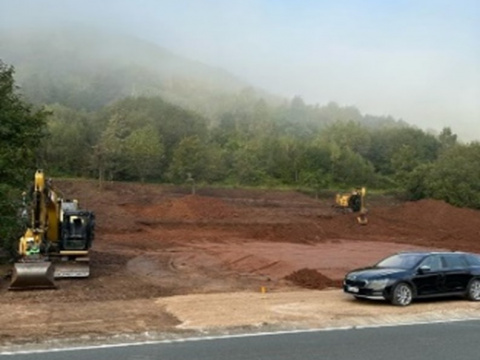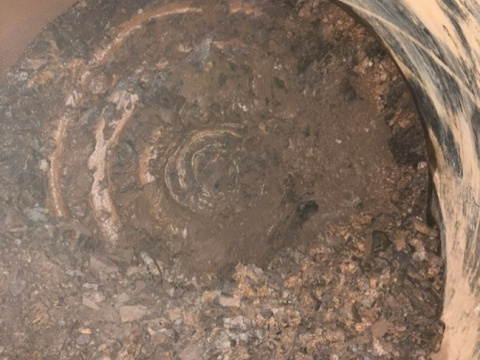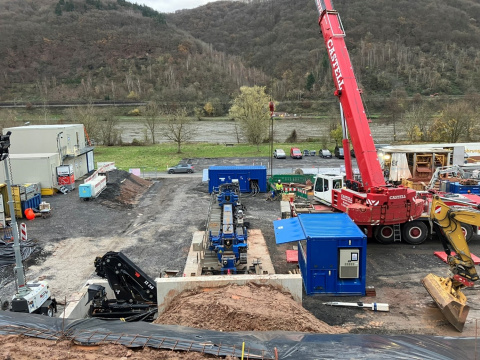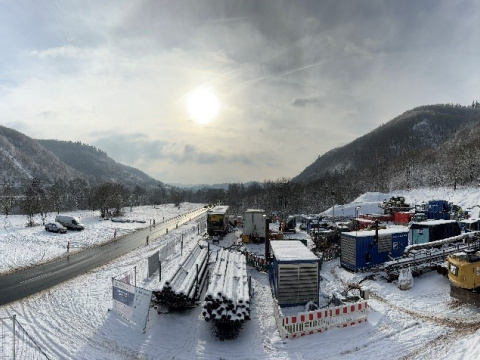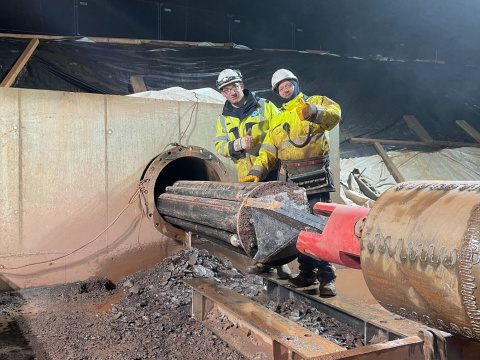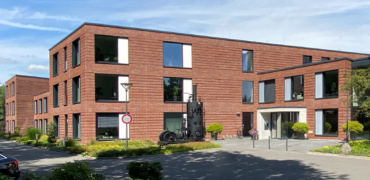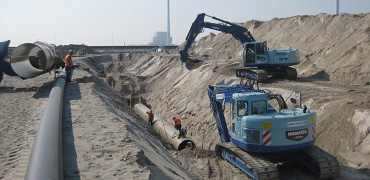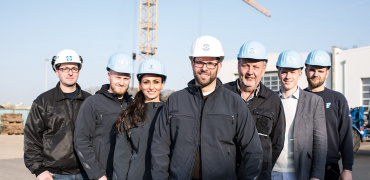Slope drilling in the Moselle Valley
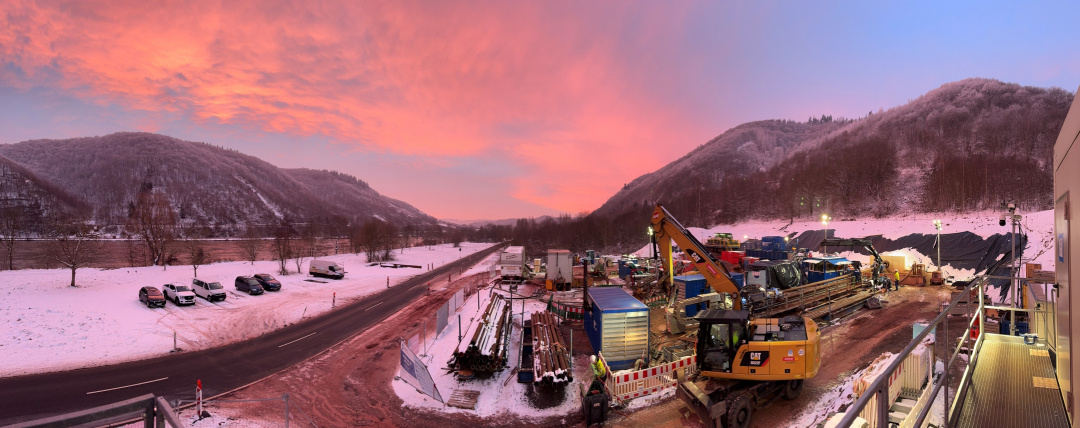
 21.02.2024
21.02.2024
1. project presentation
LMR Drilling was approached by the Hamburg-based company, Sonnen Tiefbau GmbH, in June 2023 for a feasibility assessment and budget calculation for the connection of solar parks in the greater Moselle valley near Cochem. This was followed by a site inspection in St. Aldegund, Rhineland-Palatinate, in September 2023. This resulted in an offer for a 930 m long HDD borehole with a height difference of 280 m in rocky ground.
The aim was to install a bundle of 4 HDPE cable protection pipes, OD 225 mm SDR 7.4. These HDPE pipes will subsequently be used by Sonnen Tiefbau as empty conduits for power lines, through which the electricity generated by the photovoltaic parks will be fed into the local grid. The photovoltaic parks are located on high plateaus (former wine-growing areas) in the Moselle Valley. These photovoltaic parks are connected to each other by means of various HDD measures.
The HDD drilling carried out by LMR Drilling was not a “typical” drilling. LMR Drilling explained to Sonnen Tiefbau that the realisation of this HDD borehole with such a large height difference required particularly careful work preparation and extensive engineering. LMR Drilling offered to carry out the drilling work 24/7 in order to minimise operational risks and ensure that the borehole was completed quickly.
Work preparation began with the signing of the contract at the end of October 2023.
2. project preparation
Experience from previous slope drilling projects helped LMR Drilling to recognise important points for the implementation of slope drilling and to incorporate these into the work preparation and the HDD-specific specialist engineering.
A special feature was that the borehole was to be drilled towards the summit on the valley side. By drilling “uphill”, a continuously free-standing borehole was created without the supporting force of drilling mud. This borehole would only be able to stand free safely in stable rock. As the borehole geometry meant that it could not be supported by drilling mud, LMR Drilling decided to drill the borehole with water. A continuous water supply could be guaranteed due to the proximity to the Moselle. For a clean borehole, a high flow rate in the borehole is necessary to “flush” the cuttings out of the borehole.
Unfortunately, the soil exposures and exploratory drillings provided by Sonnen Tiefbau were not very informative with regard to the soil conditions in the entry area of the HDD borehole.
As the starting site was located on a slope, a cut was excavated into the slope of the construction site area consisting of clayey soil (Fig. 1).
In order to determine the distance between the HDD entry point and a solid rock formation to be stabilised, LMR Drilling recommended that the client carry out a test drilling using an HDD mini-rig.
This test drilling revealed a distance of approx. 48 m to be stabilised up to the rock formation, which was expected to be solid, whereby a clayey soil disturbed by boulders was identified.
After considering various methods for stabilising this soil, LMR Drilling decided, in close consultation with the Client, to install an 813 mm x 16 mm steel pipe casing using the drill-pressing method.
It was crucial to integrate the casing installation into the rock formation in order to ensure adequate stabilisation of the borehole and prevent the casing from falling or running behind due to water used during drilling. By using the drill-pressing method, the output can be tested and assessed at the surface using augers.
LMR Drilling constructed an appropriate concrete structure to absorb the pulling and pushing forces generated during the jacking and HDD work, which was also intended to secure the drill string in the borehole against uncontrolled “slipping” out of the borehole. In order to absorb the interacting forces on the concrete structure to the required extent, it was dimensioned by a structural engineering office.
Discussions and on-site appointments were held with the contracted pipework contractor, Sonnen Tiefbau GmbH and LMR Drilling. In particular, a suitable pipe welding route and pipe routing for the pipe pull-in as well as completion dates were worked out.
3. preparatory work for the start of the HDD works
LMR Drilling commissioned its sister company, LF Hoch- und Ingenieurbau, to ensure that the reinforced concrete construction work could be carried out quickly. After a kick-off meeting, the reinforced concrete construction work began immediately at the beginning of November 2023 and was completed on 20 November 2023. This fast completion date was guaranteed thanks to professional work and fast-setting concrete.
In a seamless transition, a subcontractor mobilised a drill press at the HDD entry point to install the casing pipe. LMR Drilling supported the work with welders and a site manager to coordinate the work.
After four days of using the drill-pressing device and installing the casing in 10 m segments, the casing could be safely integrated into the rock section after 48 m (Fig. 2).
Parallel to the preparatory work, LMR’s HDD equipment was loaded in Oldenburg for transport to the construction site and the upcoming mobilisation.
4. the pilot hole
After rapid mobilisation of the HDD equipment, pilot drilling work began on 5 December 2023 (Fig. 3).
The first night shift began on 7 December 2023, after the crew and equipment had “adjusted” to the special features of drilling on a slope. The borehole surveying work was carried out using a gyro compass.
The drill motor, shock tool and 12.785” (325 mm) roller bit were used in the borehole.
As the drilling of the pilot borehole continued, a continuously increasing water inflow into the borehole was detected. Despite this, there were no negative effects on the pilot borehole, as the water inflow could be discharged into the Moselle by means of a discharge licence, treatment and piping. At the same time, the water inflow into the borehole was constantly monitored.
Despite the disturbed soils found, the pilot borehole was completed on 11 December 2023 with pinpoint accuracy. After the pilot borehole was completed, the cuttings and the drilling reports were analysed and a lot of helpful information was obtained. This was incorporated into the drilling programme for the upcoming widening of the borehole.
From 670 m to 930 m, clay or disturbed soil with gravelly or stony components was again detected. Based on the evaluation of the pilot borehole, LMR decided to widen the pilot borehole by means of a push rod. The obvious reason: no loss of the pilot borehole in the disturbed ground. This approach meant mobilising a fully equipped target side on the summit. All the necessary steps were taken during project preparation so that mobilisation was completed before Christmas.
On 15 December 2023, the Christmas break was “rung in” on the construction site (Fig. 4).
5. widening the drill hole
After an extension of the winter break due to flooding in the Moselle Valley area, the construction site had to be checked for damage. It was found that the secured slope in the slope cut had partially slipped. This was caused by heavy rainfall events in the period between Christmas and New Year. At a meeting with the Client and LMR at the beginning of January 2024, solutions were jointly developed and immediately implemented by the Client.
Weather forecasts for the upcoming widening of the borehole predicted severe frost down to -14 °C as well as snow, so that special and extensive conversion work was required on the drilling equipment at frost-prone points.
Once the preparations were completed, work could begin on 18 January 2024 to widen the borehole from the valley to the summit using the appropriate clearing tool.
After less than 20 individual shifts in 24/7 operation, the widening was completed on 27 January 2024. The risk of an increase in water inflow into the widened borehole was not confirmed.
During the widening of the borehole, debris and boulders with an edge length greater than 63 mm were discharged. This prompted LMR to carry out a “check trip” from the summit to the valley, which had been notified to the Client in advance, with the discharge from the borehole being monitored at all times. At the end of the “check trip”, LMR was certain that it had created a clear borehole.
6. The pipe feeder
When the water began to flow into the borehole, the Client began to discuss the possibility of insulating the borehole, but no final decision could be made until the pipe was pulled in. In order to create options for subsequent insulation, LMR was commissioned to pull in an additional 3 x DA75 SDR 7.4 PE pipes.
Once the now free and widened borehole had been created, pipe insertion could begin on 29 January 2024, which was successfully completed on schedule after 24 hours with the pipe package in the casing on the valley side; no significant tensile forces were detected on the pipe. The pipe was immediately secured on the valley and summit sides to prevent it from “slipping out” of the slope (Fig. 5).
To rule out deformation in the cross-section of the 4x OD225mm SDR 7.4 PE pipes, they were calibrated with a calibre pig on the pipe route before the pipe was pulled in. This process was repeated in the installed state on the slope. Result: No deformations in the cross-section of the pipes.
7. conclusion
With the successful pipe pull-in on 30 January 2024, LMR Drilling completed the project ahead of the planned completion date.
This fast, safe and satisfactory realisation was guaranteed by the continuous open and honest communication between the Client and its partners and representatives on the one hand and the LMR project staff on the other, as well as perfect cooperation between the day and night shifts within LMR, clear communication between the employees and forward-looking planning based on extensive experience.
Christian Weber, LMR Drilling
PROJECT INFO
PROJECT Hirzborn Slope Drilling
CLIENT Sonnen Tiefbau GmbH
APPLICANT LMR Drilling
TIME FRAME October 2023 – February 2024
PERSONNEL
PROJECT MANAGER Thomas Winkler
CONSTRUCTION MANAGER Christian Weber, Johannes Rotter
EXPERTS The entire LMR team
SUBCONTRACTORS Holland Drilling, Civil Engineering Ludwig Freytag, Brownline
DEVICE USE Drilling Rig 2500.9.3
all news
